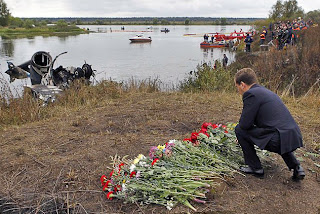Hockey
is a religion in Russia. Hockey Players become role models for people
as like football players in Europe and cricket players in south Asian
countries. Every one among us follows sports in their lives. Everyone
does have a team to support. Just for a moment think yourselves to be
in a situation when you realize that you have lost your favourite
player or the whole team you supported throughout your life forever.
What I just said is not completely abstract; in fact it really
happened to the residents of a small town in Russia called Yaroslavl
not long ago just before the beginning of the continental hockey
league.
On 7th
of September 2011, the Yaroslavl team had to make a journey from
their home town to Minsk in Belarus for a match. The plane being used
the very day was JAKA-42. The plane boarded the crew and the hockey
team and started its lift-off procedure. The plane taxied down the
runway and attained the V1 and V2 (recommended velocity for
take-off), but the plane did not go air born. Eventually the pilots
thought they were a bit slow so they might be able to do it a bit
later with a bit more speed, but they fell short of runway. After a
lot of toil the plane finally got into air but the sudden rise of
nose to twenty degrees created a lot of drag in wings and the plane
went to stall. It hit a radio tower and rolled sideways and finally
crashed into the Volga River not far from the runway. 43 dead bodies
were found only two had survived. Among the two survivors was
Yaroslavl’s star player Alexander Galimov. So what caused this
horrific accident which shook the world?
Investigators
came across twenty eyewitnesses and a runway camera and found out the
flight data recorder and the cockpit voice recorder, which are always
important for any kind of air disaster. The main reason for the
accident was inability of the plane to take off. So investigators
started their investigation on this perspective. There are three
factors responsible for a plane’s take-off. They are:-
- ENGINE THRUST: - The engines must provide adequate amount of thrust for this purpose.
- LIFT: - The wing flaps must be fully extended to get aerodynamic lift
- PROPER ANGLE: - Horizontal stability should be angled to keep tail down and bring the nose up.
Flight
data recorders showed all this instruments were properly aligned, but
saw a sudden decrease in acceleration even if the engines provided
the proper thrust. The investigators found out from the landing
wheels obtained from the crash site that the brakes were being
applied during the lift off procedure. (But how?)
Digging
into the pilot’s flight record, investigators found out that the
pilot and the first officer had trained in different versions of JAKA
planes, which is not allowed in different airlines. They were JAKA 40
and JAKA 42. Let’s have a look at some of their technical aspects
- JAKA -40- These are Soviet made planes first introduced in 1968. These could carry a total of 38 passengers.
- JAKA-42- These planes are upgraded JAKA-40 with an air turbo engine and could carry three times the number of passengers.
But the
main point of discussion is the design of the brake pedals in the
cockpit. The YAKA-40 pedal was such that the pilot’s foot was
completely cupped in it, while the YAKA-42’s pedal was such that
the foot’s heel remained on floor. If one tried to cup his foot on
the pedal it would put pressure on the upper part of the pedal
accidentally turning on the brakes. Investigators also found out that
the pilots didn’t have required hours of flying experience and the
first officer was secretly undergoing neurological treatment. His
disease had symptoms where he lost senses of his limbs, still airline
provided them with pilot licenses.
On
September 12th the last surviving member of the team
Alexander Galimov also lost his life fighting his injuries.
After
all this the airlines was to be blamed and the complete company was
shut down.
This
incident took a lot from the lives of people in Russia. The world
lost a huge personality in form of “Evan Kravchenko” (Team
Captain). He used to donate billions of rubles to helpless children
in Russia. Reports say just minutes before take-off he donated to a
girl in Moscow whom he had never met.
“Long Live the team”







